
During our Celebrity Cruise stop in Athens, we divided our time between an organized tour of the Acropolis and a chance to explore the city on our own. After the Acropolis tour was complete we found our way to the Jewish Museum of Greece.We were looking for Greek Jewish history.
Brief History of Greek Jews
Jews started settling in Greece during the 3rd century BCE. These communities expanded during the the Roman and Byzantine Empires and became assimilated into Greek culture. By the end of the 15th century, Greece became part of the Ottoman Empire. Jews from other parts of Europe migrated and shared their traditions with the established communities. Many Sephardic Jews settled in Salonika.
A new Greek state was establishd in 1832. At that time, Jews did not reside in the deserted city of Athens. After Athens became the capital, Bavarian Jews started to settle in Athens. The Rothschild family became prominent members of society. The Constitution of 1844 granted all Greek citizens equal civil rights. By the end of the century approximately 10,000 Jews lived in Greece.
After the the Balkan Wars (1912-13) the Jewish population surged to close to 100,000 with the majority of people residing in Salonika. When the Germans invaded Greece during WWII, there were approximately 78,000 Jews residing in th country. The Shoah claimed the lives of 87% of the total population.
Prior to WWII, there were 28 Jewish communities in Greece. Only nine remained after the war- Athens, Thessaloniki, Larissa, Ioannina, Trikala, Volos, Chalkis, Carfu, and Rhodes.
In the first half of the 20th century, two synagogues were built- Ioannina (Romaniote) Synagogue (1904) and Beth Shalom Synagogue (1935)
Jewish Museum of Greece
The Jewish Museum of Greece was founded in 1977 to collect, preserve, research, and exhibit the 2300 years of Jewish life in Greece. It is organized on multiple levels that spiral around a octangular atrium that is lit by a central skylight in the roof.
There is a small gift shop that offers books and a few items.
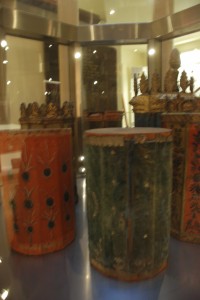
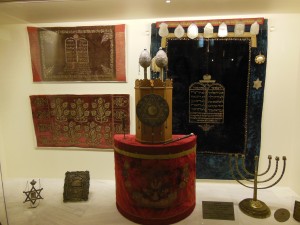
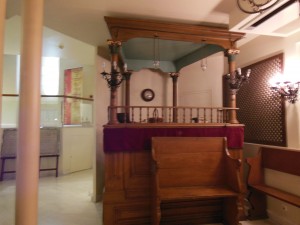
On the first level we viewed the restored interior of the Romaniote Synagogue of the Jews of Patras. The exhibit included the ark and a variety of furnishings including cylindrical wooden cases for Torahs, embroidered textiles, and different items from the synagogue.
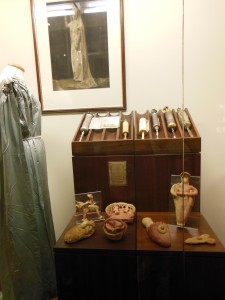
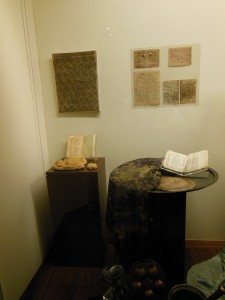
When we came upon the second level we viewed different objects associated with the observance of the Jewish Shabbat (Sabbath), Jewish festivals, holidays and everyday life.
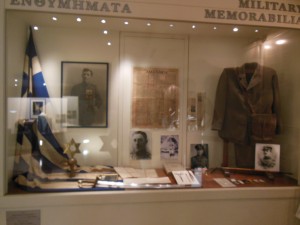
On the third level, we viewed different pieces of Jewish history that were captured in photographs, publications, newspaper articles, and military paraphinalia.
In an alcove, we were able to watch a short educational film.

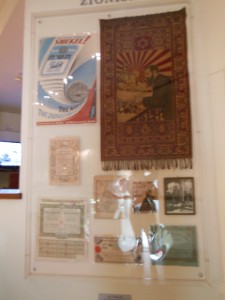
Winding our way upward, we found our way to the area that is dedicated to the Shoah (Holocaust). Artifacts from the concentration camps, the prisoners’ liberation, and their return from the camps is documented in this section. We learned that Greece was divided into three occupations zones: the German, the Bulgarian, and the Italian. The Head of the Greek Orthodox Church, Archbishop Damaskinos, was the only head of a European Church to officially protest the persecution of Greek Jews. Signs described some of the horrid details of the Nazis era.
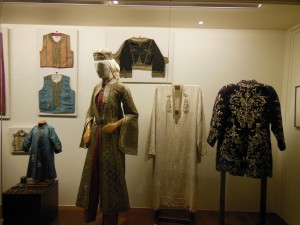
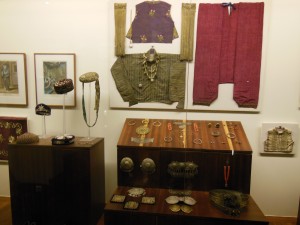
A step back in history is found in the next area. Clothing that represented life from the middle of the 18th century until the 1940s was on display.
The last level housed items that were used for everyday life and different Jewish celebrations such as brit mela (ritual circumcision), b’nai mitzvot, marriage, and death rituals.
On one of the top levels, we saw photographs from the Athens Holocaust Memorial. We were told that it was near a synagogue a couple of miles away. With map in hand, we traipsed toward the memorial. We passed large groups of police in riot gear and walked through a variety of neighborhoods. Eventually we found the memorial that was desecrated with some graffiti. Nearby buildings also had painted words. We were able to take photograph that did not highlight these eyesores.
Athens Holocaust Memorial
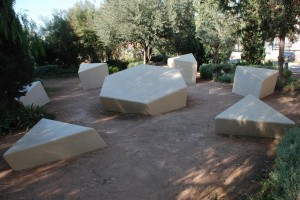
Beth Shalom Synagogue in Athens
A short distance away, we found two synagogues-one across from the other.
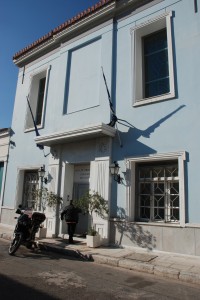
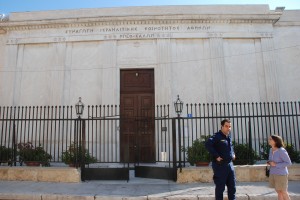
A policeman and a guard told us that it was not possible to enter either building. I was disappointed. Back on board ship, we learned that a small group of Jews had visited Beth Shalom earlier and were allowed to enter. I suggest that you call in advance.
If you are visiting Athens and are interested in looking for Jewish history, plan a visit to the Jewish Museum of Greece.
Related Blogs:
Baking Challah Per Celebrity Cruises
Hamat Teverya National Park- An Historical Gem in the Galilee
Bet She’arim- Important Necropolis from Talmud Era
A Step Back in Time- The Jewish Catacombs in Rome
Jew Town and the Paradesi Synagogue
Bio
Sandra Bornstein is the author of MAY THIS BE THE BEST YEAR OF YOUR LIFE. It is available on Amazon.
Sandra’s memoir highlights her living and teaching adventure in Bangalore, India. She is a licensed Colorado teacher who has taught K-12 students in the United States and abroad as well as college level courses. Sandra is married and has four adult sons.
The memoir was a finalist in the Travel category for the 2013 Next Generation Indie Book Awards, the 2013 International Book Awards, the 2013 National Indie Book Excellence Awards, 2013 USA Best Book Awards, and a Honorable Mention award in the Multicultural Non-Fiction category for the 2013 Global ebook Awards.
Greece is on my top 10 Travel Wishlist of places to see! I used to work for the Jewish Theological Seminary in New York City, which everyone found odd at the time since I am Christian, but I greatly enjoyed working there, and will add this museum to my list of places to see as well!
Tracy, I hope that you will eventually travel to Greece. Let me know if you do. What are the other 9 places that you hope to see?